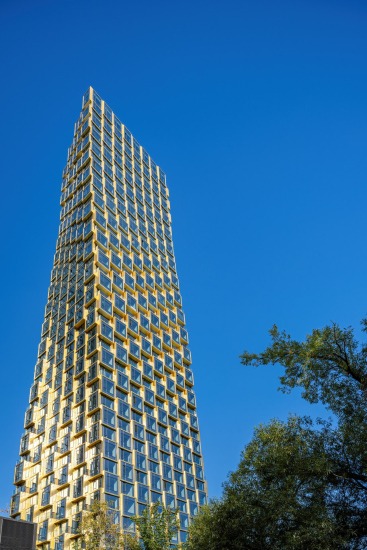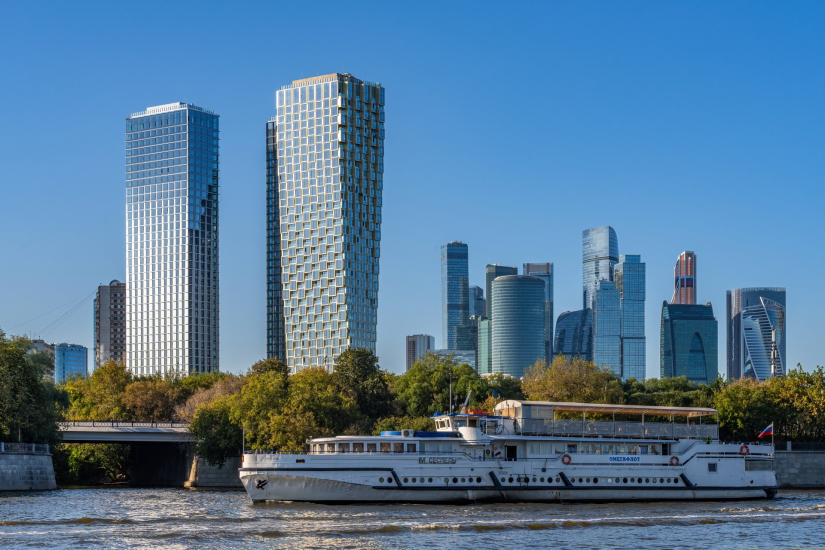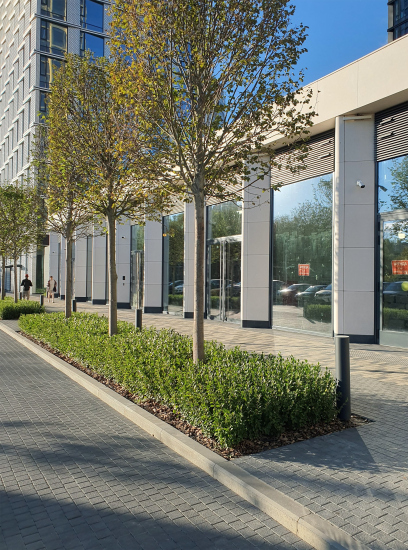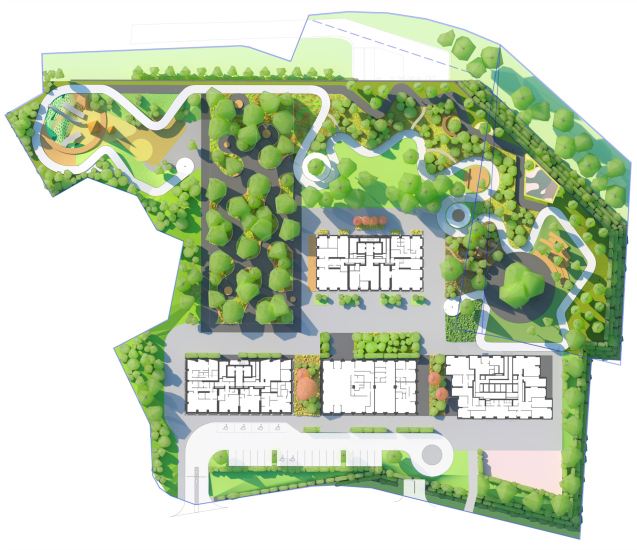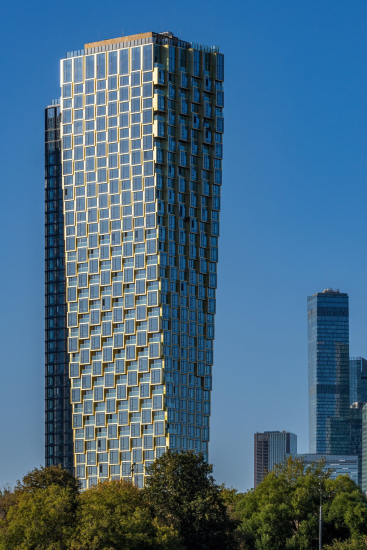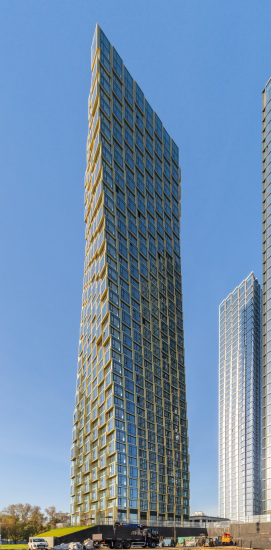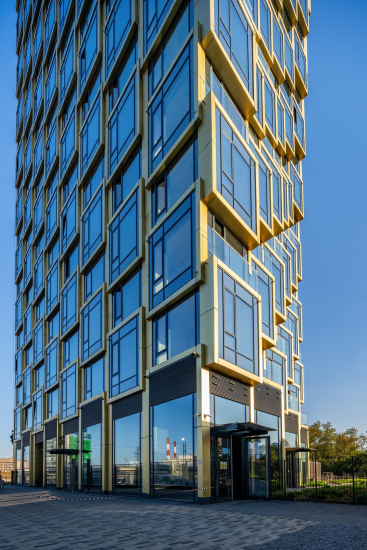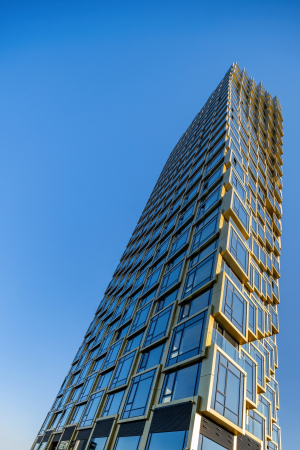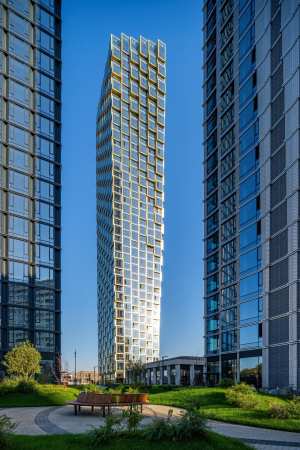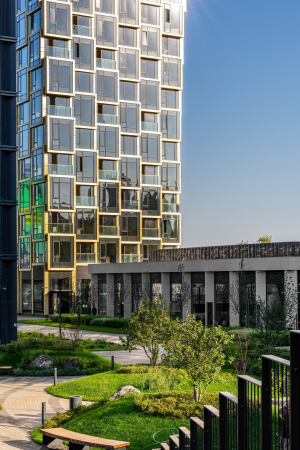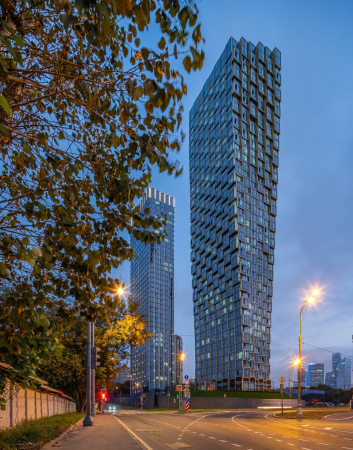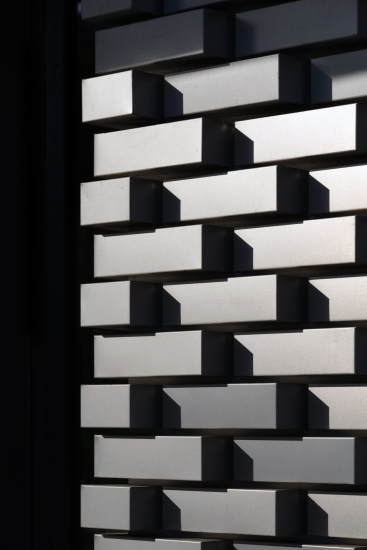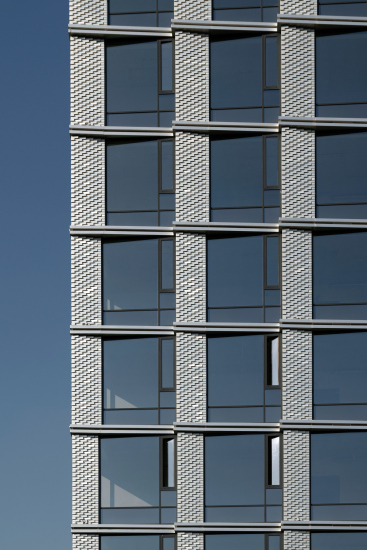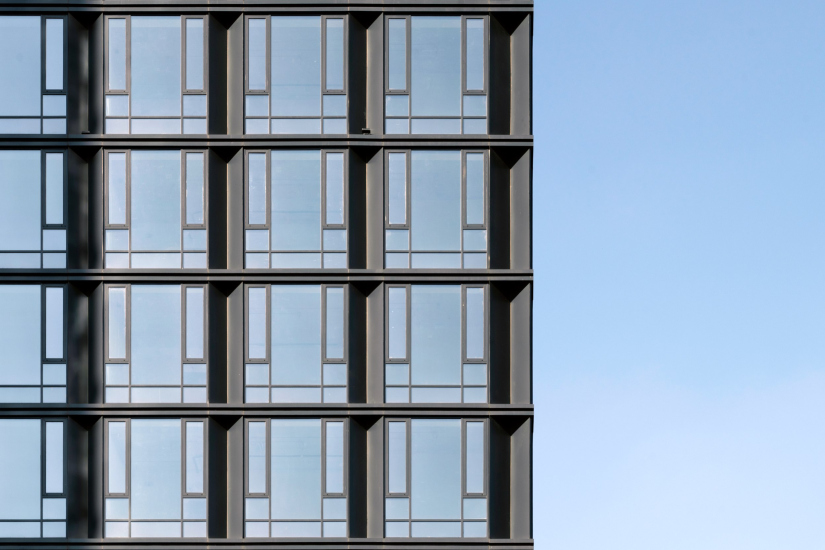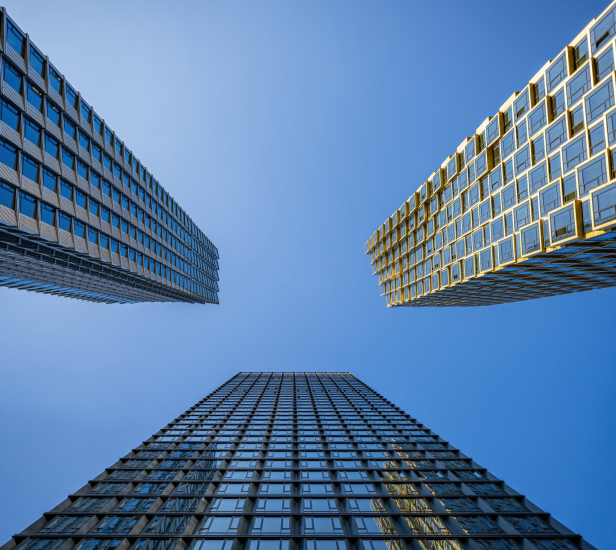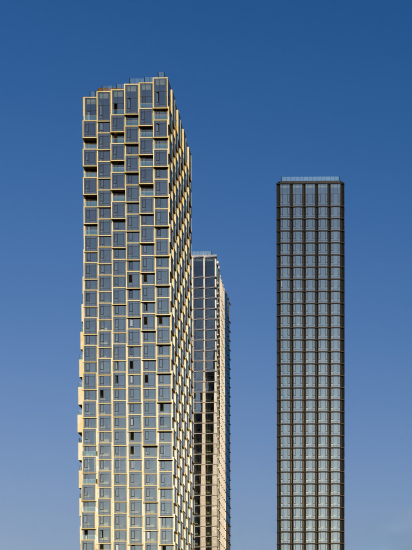The shiny frames seem to assemble the shape before our very eyes, visually floating around a central axis – a captivating effect. The tower’s form is slender, and from a moving perspective, it changes almost imperceptibly – but continuously. It transforms when viewed from a car or from a boat on the Moscow River, where the golden vertical line also establishes itself as a defining landmark of this area.
Situated within direct view of Moscow City, the HIDE towers echo the city’s high-rise accents of recent years and decades.
HIDE Housing Complex
Copyright: Photograph © Dmitry Chebanenko / provided by ADM architects
We first covered the HIDE premium residential complex a few years ago: it comprises three towers of equal height, each with 41 floors, standing atop a stylobate embedded into a slope with a height difference of around 5 meters. This slope allowed for the entrance to an underground parking garage from the lower part of 1st Setun Passage, featuring a gabion wall. On the roof of the stylobate lies a calm, city-overlooking space that includes a private courtyard and an “appendix” of a city street-square in front of the entrance to the complex
The HIDE complex’s layout shines in its simplicity: the “footprints” of the four buildings are almost identical, yet three are high-rise residential towers, while the fourth is a public center. This structure isn’t vertical but stretches horizontally with large white partitions. The public center houses the main entrance, social spaces, a children’s play area, and a waiting room for delivery persons. Reminiscent in part of modernist “glass box” stores, it exudes a more representative quality, evoking classical pilasters or even a “stoa” portico, yet with floor-to-ceiling glazed facades.
The golden tower, however, is the star of the complex’s architectural composition. Initially, all the three towers were designed to look the same. But in the final stages of design – by that time, even the excavation was completed – a new direction took shape. A push for architectural distinction emerged from the city’s leadership, particularly Mayor Sergey Sobyanin, calling for a search for unique forms. Responding enthusiastically, architects Andrey Romanov and Ekaterina Kuznetsova, along with their client, MR Group, proposed a change: instead of placing the stairwell and elevator core along the northern façade as with the other two towers, they positioned it in the very center of the volume. This allowed them to “sculpt” the tower from “pixels” of substantial size, giving it a sculptural quality from all angles.
This shift – or refinement – in the design took place in early 2020. For ADM architects, the quest for a new tower aesthetic began with the River Park Towers on Kutuzovsky Avenue, followed by the Famous tower within the Fili Tower complex, and, finally, the golden tower at HIDE that we are examining now. ADM’s approach to high-rise form has since become their signature technique, prioritizing the flexibility to manipulate the building’s silhouette.
Andrey Romanov, leader of ADM architects
The city leadership’s attention to architectural form, to focal points in emerging panoramas, is a crucial trend in Moscow’s development as a modern metropolis. I won’t deny that it’s significant for us as architects; it allows us to propose more complex – though, I stress, always achievable – solutions in form and composition. In a sense, HIDE marks the beginning of this journey, as it was in 2020 that such experiments became possible, and I’m very pleased we managed to change the form of one of the complex’s towers in a way that makes it more interesting and prominent. I like how it looks within the cityscape.
Though I think if we had managed at that moment to change all three towers just as radically, using a single design approach, it would have looked even better.
Though I think if we had managed at that moment to change all three towers just as radically, using a single design approach, it would have looked even better.
The golden “scales” – a design element that the architects liken to the skin of a scaled creature, as the resemblance is indeed striking – create a unique flexible-yet-discreet articulation. These scales are formed by modules of window bay projections. In HIDE, these projections are clustered along the wider facades at the base and on the narrower facades mid-tower. Rather than noticing this detail specifically, one only sees the flowing “wave” moving across the surface, which either subtly oscillates the entire outline or perhaps seems to be a response to it.
The square projections and checkerboard arrangement introduce a regular, rhythmic foundation to the design, anchoring the volume so that, despite its fluidity, it remains calm and stable. This is evident both in the building’s plan and in the cityscape, where the movement embedded in the tower’s form resembles the contrapposto stance of a walking figure: the “leg” extends southward toward the Third Ring Road, while the “shoulder” leans away. This multi-faceted form also gives the impression of a spiral, adding a sense of upward momentum.
Choosing the golden color was a challenge in itself, the architects explain. While neutral gray tones are easily controlled and reproduced using RAL coating, warmer tones, particularly gold, are much more challenging to execute. ADM opted for anodized aluminum with a cool undertone. When asked why they didn’t choose a naturally aging material like copper or bronze, they responded that “The final form wasn’t designed with aging in mind. We selected a material that would retain its color over time so the tower will look the same as it does now”. The color was meticulously tested on mock-ups to achieve the desired effect.
These golden frames are central to the tower’s identity, capturing over the better half of the viewer’s attention.
However, the golden tower doesn’t stand alone. The second, silver tower retains aspects of the original design, including vertically narrowing window mullions reminiscent of calligraphy strokes or bird feathers, and a jagged “brick” texture. Here, the “bricks” are crafted from folded aluminum sheets, revealing the material’s subtle detail only up close and further enhanced by reflective highlights.
This detail becomes apparent only upon closer inspection – and also because the silver facade, much like the golden one, produces a multitude of glimmers and reflections. The comparison to Laurelin and Telperion comes naturally, as the two towers seem to echo the radiance of the legendary trees.
The third tower, set back on the site, creates zones within the courtyard – a smaller court d’honneur and a larger promenade area. Its façade, with glass and deep black partitions, exudes a more restrained style. The surface is composed of flattened bay windows assembled in a flush pattern, reminiscent of the rational modernism of the early 20th century.
Yet perhaps most striking is how the setbacks of the black tower seem like an inversion of the triangular pilasters on the public center. It’s as if the center is a small, white “soul,” while the black tower is its “tall shadow”. The center acts as a simple monochrome core, framed by the silver western and golden eastern towers, like the moon and the sun.
The result is quite cosmic-looking.
In essence, the four volumes form a dialogue of their own, creating a rhythm and resonance among them. The black tower is like a graphite pillar, lending stability to the composition. The silver tower flutters like a line of flags in the wind. Meanwhile, the golden tower “steps” boldly toward the roadway, standing tall like Nike on the Acropolis. The boldest and most brilliant of the three, it engages in a dialogue with the sprawling, ever-growing city that encircles this new residential complex with its roads. It’s no coincidence that the name of the bureau translates to “Architectural Dialogue with the Megalopolis”.




